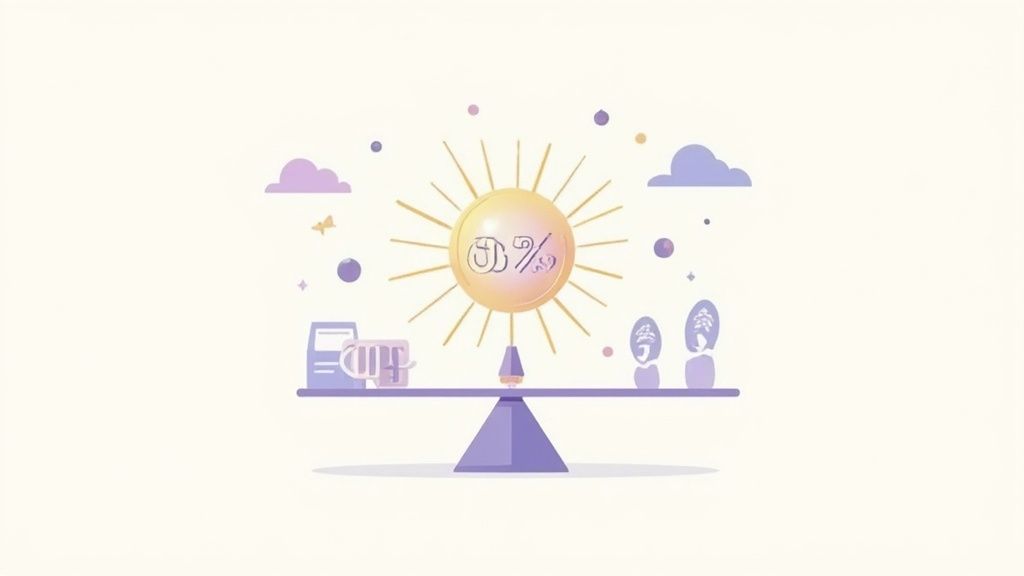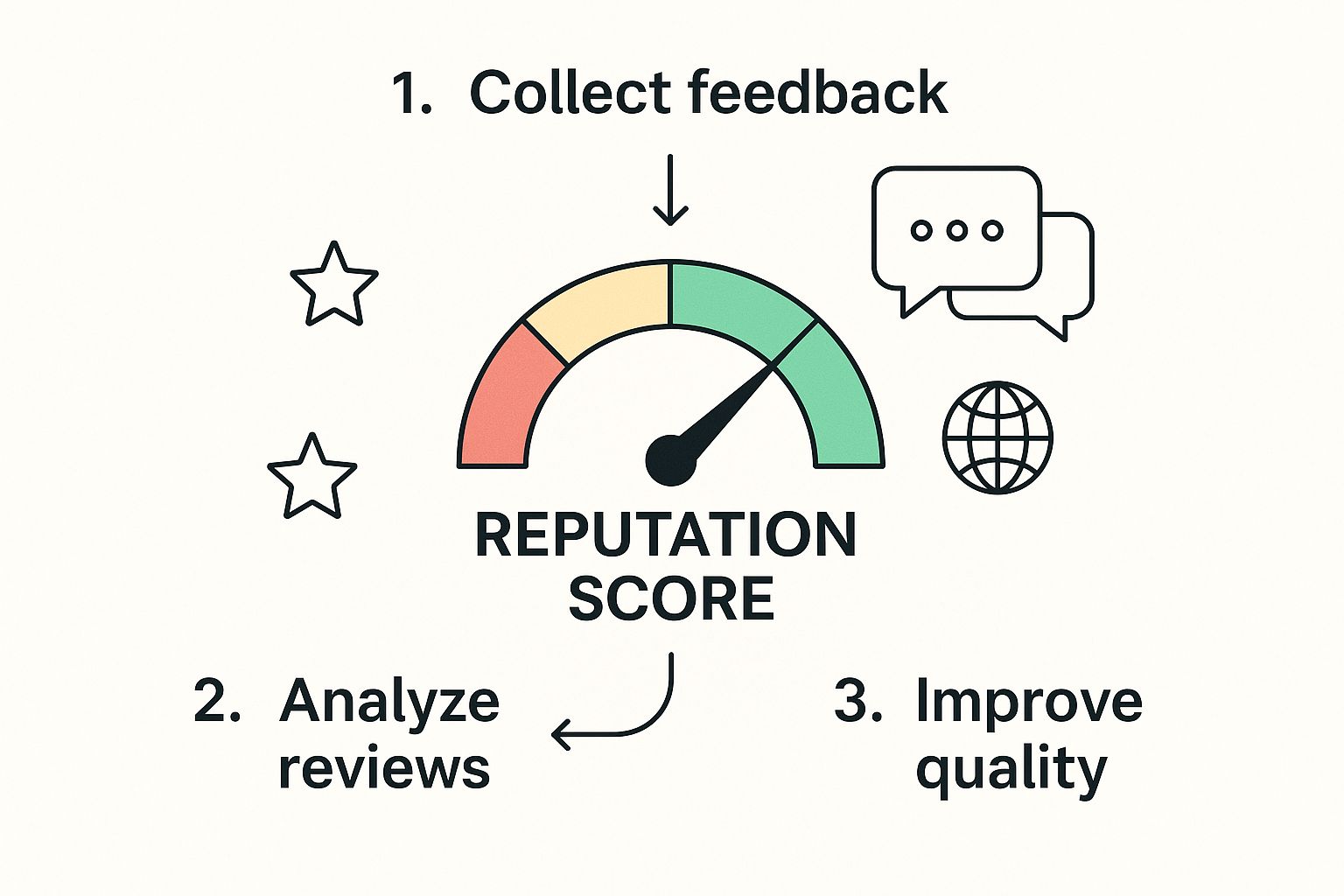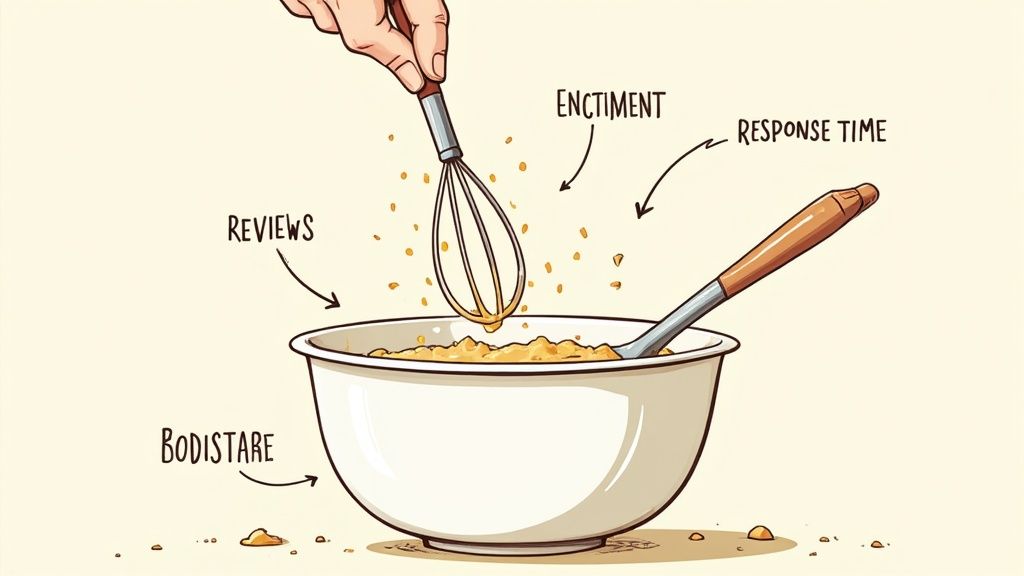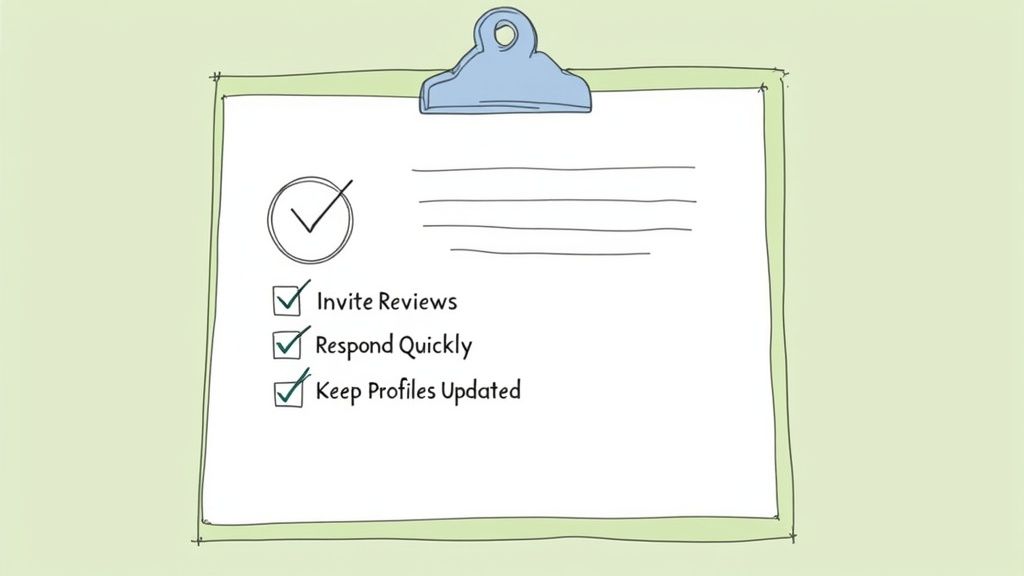What Is a Reputation Score?

Ever heard of a reputation score? Think of it like a credit score, but instead of tracking your financial history, it measures your digital trust and credibility. It’s a single, powerful number that pulls together all your online footprints—from reviews and social media chatter to how you engage in communities—to paint a picture of who you are online.
Decoding Your Digital Identity
At its heart, a reputation score is a quick snapshot of how trustworthy you appear in the digital world. It’s far more than just a vanity metric; this number can genuinely open or close doors for you, whether you're trying to join a new community, get access to exclusive opportunities, or even secure financial services. It replaces gut feelings with a data-backed look at your credibility.
This whole idea is a huge step up from simple star ratings. A reputation score crunches countless data points into one easy-to-understand metric. It's essentially a numerical value that reflects how an entity is seen online, calculated by pulling from sources like customer feedback, social media engagement, and even business listings. Things like review sentiment, how quickly you respond to messages, and how often complaints pop up are all weighted to create the final score.
The infographic below really brings this to life, showing how different inputs can push your score up or down.

As you can see, a healthy score—that needle in the green zone—comes from consistently positive interactions and feedback.
Key Components of a Reputation Score
To really get what a reputation score is all about, it helps to break down the pieces that go into it. The table below outlines the core elements that typically feed into these scores, giving you a better sense of the building blocks of digital trust.
| Component | What It Measures | Example |
|---|---|---|
| Engagement | The quality and frequency of your interactions within a community or on a platform. | Actively participating in Discord discussions, voting on proposals, or contributing to a project's GitHub. |
| Feedback & Reviews | What others are saying about you or your brand across various review sites and platforms. | Customer reviews on Google, product ratings on Amazon, or peer feedback in a DAO. |
| Verifiable Actions | On-chain or off-chain activities that can be proven and are tied to your digital identity. | Completing specific tasks for an airdrop, holding certain NFTs, or having a long transaction history. |
| Social Proof | Your influence and presence on social media platforms. | Follower count, engagement rates on posts, and the sentiment of mentions. |
Each of these components adds a different layer to the overall picture, creating a more holistic and reliable measure of your reputation than any single metric could on its own.
Why This Score Is Becoming Essential
In a world overflowing with digital noise, trust has become the most valuable currency. A strong reputation score cuts through that noise and acts as a powerful signal, making it easier for others to make decisions. Are they going to buy your product, join your community, or partner with you on a project? Your score gives them a quick, reliable gut check.
A reputation score isn't just about what you've done in the past; it's a predictor of future behavior and a key indicator of your reliability in an increasingly decentralized world.
This is especially critical in Web3, where many interactions happen between pseudonymous wallets. In that space, your score can be the key to unlocking access to DAOs, qualifying for airdrops, or even earning governance rights. For marketers and community builders, this metric is the secret to cultivating an engaged, high-value user base—which is why platforms like ours are so focused on using verifiable actions to build that trust.
You can see how top Web3 teams are building trust by checking out our testimonials at https://domino.run/testimonials. And if you're looking to get a deeper handle on how reputation is evolving in decentralized spaces, a great Web3 Dictionary can give you the essential terms and context you need.
How Is a Reputation Score Actually Calculated?

So, how does all this data get crunched into a single, neat little number? It's not magic, but it is complex. Think of it like a chef's secret recipe. You can’t just toss a bunch of ingredients together and hope for the best; you need the right ones, in the right proportions, mixed just so.
A reputation score is built on a similar principle. It uses a specific algorithm—the recipe—to blend different data points into one meaningful score.
It's way more sophisticated than just averaging out your star ratings. Modern reputation systems use smart algorithms that assign different weights to different factors. For instance, a detailed, glowing review from a verified user last week should obviously carry more weight than a one-word "meh" from two years ago. The algorithm gets that.
This whole process is designed to make sure the final number is a fair and accurate snapshot of where you stand right now. Let’s break down the key "ingredients" that go into the mix.
The Core Ingredients of Your Score
At its heart, a reputation score is a mashup of quantitative data (the numbers) and qualitative data (the feelings). Every bit of information tells a piece of the story, and the algorithm's job is to put that story together.
Here are the inputs that usually matter most:
- Review Volume and Velocity: This isn't just about how many reviews you have, but how often they’re coming in. A steady flow of fresh feedback signals that you're relevant and active.
- Sentiment Analysis: This is the cool part. Algorithms read the actual words people are using. Are they saying "love it" and "super helpful," or are they using words like "frustrating" and "avoid"? This gets to the emotional core of the feedback, beyond just a star rating.
- Response Time and Rate: How fast and how often do you reply to feedback? A quick, thoughtful response—to both good and bad comments—shows you’re paying attention and that you care. That's a huge plus.
- Profile Consistency: Does your name, address, and other info match up across all the platforms you're on? Inconsistencies can look sloppy or, worse, untrustworthy, and that can ding your score.
Of course, not all of these are created equal. A flood of angry reviews will tank your score much faster than a slightly slow response time. Knowing which levers to pull is the first step to taking control. It's a lot like the process of measuring marketing campaign effectiveness, where you have to weigh different metrics to see what’s really working.
Putting It All Together
Once the system gathers all these data points, the algorithm gets down to business. It assigns a specific weight to each factor and then calculates the final score. You can almost picture a big dashboard with a bunch of dials for things like sentiment, recency, and volume.
A reputation score is a living number, not a static one. The algorithm is constantly turning those dials as new information comes in, so the score is always a up-to-the-minute reflection of your standing.
For example, a sudden wave of spammy, one-star reviews can crank the "sentiment" dial way down, causing your score to drop fast. But on the flip side, a week full of awesome, detailed reviews can turn the "velocity" and "sentiment" dials way up, giving your score a nice boost. This constant ebb and flow is what makes it such a reliable, real-time pulse check on your community's trust.
Why Your Reputation Score Matters More Than Ever
Let's be real: a good reputation score isn't just some vanity metric you check once in a while. It’s a genuine asset, one with real-world consequences that can make or break your success online.
For businesses, it’s directly tied to customer trust, how you show up in search results, and—let's not forget—your revenue. For individuals, especially in the growing gig economy and the wild west of Web3, it's your ticket to everything from landing new projects to getting into exclusive communities.
Think about the last time you were hunting for a new restaurant. Did you just wander in blindly? Probably not. You likely pulled up Google Maps and checked the rating first. That number, a simple reputation score, shaped your decision. The same thing happens everywhere online, but the stakes are often much, much higher.
A high score is your digital seal of approval. It tells people they can trust you, buy from you, or collaborate with you. On the flip side, a low score is like trying to run a race with weights on. Opportunities start to disappear, potential customers scroll right past, and you're left wondering why you're not getting any traction.
The Business Impact of Digital Trust
For any company, a solid reputation score is a direct path to a healthier bottom line. This isn't about feelings; it’s about cold, hard results. When a potential customer sees you have a high score backed by great feedback, their confidence in you shoots up. And the data doesn't lie—people consistently spend more with businesses they trust.
This trust gives you a few major advantages:
- Higher Search Visibility: Search engines like Google love businesses with strong reputations. They'll push you higher in local search results, which means more free, organic traffic coming your way.
- Increased Conversion Rates: A positive score melts away that last-minute hesitation people feel before clicking "buy." The result is more sales and more sign-ups.
- Improved Customer Loyalty: When customers know they can count on you, they don’t just come back—they become your biggest fans and tell their friends about you.
A strong reputation score is a leading indicator of future success. Research from RepTrak shows that reputation directly influences stakeholder behavior, from purchasing decisions to investment interest, making it a critical metric for long-term growth.
A Gateway to Web3 Opportunities
In the decentralized world of Web3, where you're often just a wallet address, a verifiable reputation score becomes absolutely essential. It’s basically your digital passport, proving you're a credible player in a system built on trustless interactions.
Since you don't have a traditional resume, your on-chain activity and community contributions become your CV. A high score can open doors to:
- Exclusive DAOs: Many decentralized autonomous organizations (DAOs) have a reputation threshold for entry. They want to make sure new members are committed and not just there for a quick flip.
- Airdrop Eligibility: Projects often use reputation scores to reward their most active and helpful community members with token airdrops, weeding out bots and freeloaders in the process.
- Governance Rights: In many communities, a higher score equals more voting power on proposals. It gives you a real say in the future direction of the project.
In this space, your reputation isn't just about how people see you. It's a functional tool that gives you tangible utility and influence.
From Star Ratings to Smart Algorithms
Measuring what people think of you isn't a new idea, but how we do it has completely changed. Think back to the early days of the internet. Trust was pretty straightforward. You had the classic five-star rating on a product page or a simple survey asking, "How likely are you to recommend us?"
These old-school methods were easy to understand and worked well enough for a while. They gave you a quick, at-a-glance idea of what people thought. But as our online world got bigger and messier, these simple scores started to feel a bit flimsy. They just couldn't capture the full story behind what people were saying across all the different corners of the web.
The Shift to Deeper Insights
The game really changed when online reviews and social media blew up. All of a sudden, a reputation wasn't just a number. It was a massive, sprawling conversation happening everywhere at once—on blogs, Twitter, forums, you name it. A single score couldn't possibly do justice to the detail in a heartfelt review or the impact of a viral tweet.
This explosion of feedback created a huge need for a smarter way to measure trust. Businesses and communities needed to listen to the entire conversation, not just count the stars. This whole evolution was really pushed by us, the consumers. As we started relying more on online reviews to make decisions, the systems had to get better at understanding them. By 2020, an incredible 97% of consumers were reading online reviews for local businesses. You can dive deeper into how this trend developed over at inmoment.com.
This is where smart algorithms stepped in to save the day.
We stopped just asking if people liked something and started trying to understand why. The new systems learned to pick up on sentiment, context, and credibility, setting the stage for the powerful reputation scores we have today.
The Modern Algorithmic Approach
Today’s reputation scores are a different beast entirely. They're powered by clever algorithms that crunch hundreds, sometimes thousands, of data points in real time. These aren't just counting up good and bad comments anymore. They're weighing everything based on crucial factors like:
- Source Credibility: Is this feedback from someone who actually bought the product or just a random anonymous account?
- Recency: A review from yesterday is way more important than one from five years ago. It’s just common sense.
- Sentiment Intensity: The algorithm knows the difference between a lukewarm "It was okay" and a furious "This is the worst thing I've ever bought."
This leap from basic feedback forms to a deep, digital analysis gives us a much clearer and more accurate picture of trust. It’s why a modern reputation score is infinitely more powerful than a simple star rating could ever hope to be.
Practical Steps to Improve Your Reputation Score

Knowing what a reputation score is gets you in the game. But learning how to actually improve it is how you win. There’s no magic button here; it's all about small, consistent actions that add up over time to build genuine trust.
Think of it like tending a garden. A healthy reputation needs constant attention. You have to pull the weeds (like handling bad feedback) and provide plenty of water and sunlight (by encouraging good reviews). If you ignore it, it won't die overnight, but with a little care, it will absolutely flourish.
Actively Encourage and Manage Feedback
The most straightforward way to move the needle on your score is through the feedback you get from others. Don't just sit back and hope for good reviews to show up. You need a system.
After someone has a great experience, make it ridiculously easy for them to talk about it. A simple follow-up email or a pop-up in your app can work wonders. After all, research suggests 70-80% of users will leave a review if you just ask them to. Creating these moments is a simple way to stack the deck in your favor.
Here's a pro-tip: Responding to feedback is just as important as getting it. When you reply to comments—good and bad—it shows everyone that you're listening and that you actually care.
This kind of two-way conversation is huge. A thoughtful response to a negative comment can sometimes turn an unhappy person into a fan. Plus, it shows potential new community members that you're committed to making things right. This is a core part of building trust and overcoming uncertainty in campaigns, turning every piece of feedback into a chance to strengthen your reputation.
Maintain Consistency Across All Platforms
Your digital identity needs to be the same no matter where people find you. That means your name, your branding, and your core info should be consistent across your website, social media, and any other platform you're on. Inconsistencies create confusion and make you look less credible to both people and algorithms.
Take a few minutes to do a quick digital audit. Check for:
- Consistent Naming: Is your brand or personal name spelled the same way everywhere?
- Updated Information: Are your contact details and descriptions up-to-date on all profiles?
- Unified Branding: Do your profile pictures, logos, and cover images match?
This kind of digital housekeeping might feel minor, but it signals professionalism and makes it easier for reputation systems to connect the dots and see you as a reliable entity.
Engage Authentically with Your Community
At the end of the day, a high reputation score comes from real engagement, not just having a profile. You have to be part of the conversation. Share things people find useful, answer questions, and interact like a real human.
This is non-negotiable in Web3 communities. Your activity in Discord channels, on governance forums, or on X (Twitter) is a public ledger of your contributions. The more you show up and add value, the better. While you can automate some outreach to stay consistent, you can’t fake authenticity. For tips on striking that balance, our guide on marketing automation best practices has some great ideas.
Showing up consistently proves you're a valuable member of the ecosystem, and your score will naturally reflect that over time.
To help you prioritize, here’s a quick breakdown of where to focus your energy for the biggest impact.
Action Plan for a Higher Reputation Score
| Activity | Effort Level | Potential Impact on Score |
|---|---|---|
| Updating your profile picture | Low | Low |
| Responding to a positive comment | Low | Medium |
| Actively asking for reviews | Medium | High |
| Responding thoughtfully to negative feedback | Medium | High |
| Participating in community governance | High | Very High |
| Creating valuable, original content | High | Very High |
Focus on the medium-to-high impact activities. They take more work, but the payoff for your reputation score is well worth it.
Got Questions About Reputation Scores? We've Got Answers.
The idea of a "reputation score" is popping up everywhere, and naturally, so are a lot of questions. It's a really useful concept, but I get that the details can feel a bit fuzzy at first. Let's clear up some of the common questions people ask about how these scores actually work.
Think of this as your quick-and-dirty FAQ to nail down the specifics.
How Often Does a Reputation Score Change?
Your reputation score isn't a static, once-a-year report card. It’s a living number that can shift all the time—sometimes even daily. It's constantly being fed new data, whether that's fresh customer reviews, social media chatter, or new on-chain activity.
How much it bounces around really depends on the platform and how much new info is coming in. A business getting hundreds of reviews every day will see their score wiggle around a lot more than a small community with just a handful of new interactions each month. The best way to think about it is as a live pulse-check on your current standing.
Can I Figure Out My Own Reputation Score?
So, you can't perfectly replicate the secret sauce algorithms these platforms use, but you can absolutely do a manual "reputation audit" to get a pretty good sense of where you stand. It's actually a great habit to get into.
Here’s how you could do a quick self-check:
- Pull up your average ratings on major sites like Google or Trustpilot.
- Skim through your most recent comments and mentions. What's the general vibe?
- Check your business listings on different platforms. Are they accurate and consistent?
This won't spit out an exact number, but it will give you a strong gut feeling for your reputation. More importantly, it helps you spot the exact areas that might need a little love.
Is a Reputation Score Just a Credit Score for the Internet?
That's a fantastic analogy, and it's pretty close. A credit score measures your financial trustworthiness based on how you handle debt. A reputation score, on the other hand, measures your social and professional trustworthiness based on your online actions and what others say about you.
They're both just numbers that represent trust, but in different arenas. A bad credit score stops you from getting a loan. A bad reputation score can stop you from getting customers, joining a cool community, or getting access to new opportunities.
Ultimately, they both serve the same function: giving people a quick, data-driven shortcut to decide if they can trust you.
How Badly Do Negative Reviews Hurt My Score?
Negative reviews will definitely knock your score down, but it's not as simple as "one bad review = minus 10 points." Modern algorithms are a lot smarter than that.
They look at a bunch of different things. How harsh was the review? How old is it? And—this is a big one—did you actually respond to it? A thoughtful, professional reply to a nasty comment can seriously soften the blow. It shows the platform (and any person reading it) that you’re paying attention and you care. A pattern of ignored complaints, though? That’s a fast track to a lower score, as it signals you’re not accountable.
Ready to build a powerful reputation and get your Web3 community buzzing? Domino makes it dead simple to create and automate reward-based quests that get people involved. You can launch campaigns in minutes, use AI to verify tasks, and watch your community come to life.
Level Up Your dApps
Start using Domino in minutes. Use automations created by the others or build your own.
